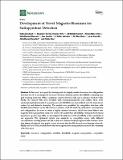Por favor, use este identificador para citar o enlazar a este item:
http://hdl.handle.net/10261/208554COMPARTIR / EXPORTAR:
 SHARE SHARE
 CORE
BASE CORE
BASE
|
|
| Visualizar otros formatos: MARC | Dublin Core | RDF | ORE | MODS | METS | DIDL | DATACITE | |

| Título: | Development of Novel Magneto-Biosensor for Sulfapyridine Detection |
Autor: | Jamshaid, Talha; Tenório-Neto, Ernandes Taveira; Baraket, Abdellatif; Lebaz, Noureddine; Elaissari, Abdelhamid; Sanchís Villariz, Ana CSIC; Salvador, Juan Pablo CSIC ORCID; Marco, María Pilar CSIC ORCID CVN ; Bausells, Joan CSIC ORCID ; Errachid, Abdelhamid; Zine, Nadia | Palabras clave: | Biosensors Sulfapyridine SA2BSA BioMEMS Magnetic nanoparticles Competitive assay |
Fecha de publicación: | 21-abr-2020 | Editor: | Multidisciplinary Digital Publishing Institute | Citación: | Biosensors 10 (4): 43 (2020) | Resumen: | In this work, we report the development of a highly sensitive biosensor for sulfapyridine detection based on an integrated bio micro-electromechanical system (Bio-MEMS) containing four gold working electrodes (WEs), a platinum counter electrode (CE), and a reference electrode (RE). Firstly, the cleaned WEs were modified with 4-aminophenylacetic acid (CMA). Then, (5-[4-(amino)phenylsulfonamide]-5-oxopentanoic acid (SA2BSA) was immobilized onto the transducers surface by carbodiimide chemistry. The analyte was quantified by competitive detection with SA2BSA immobilized on the WE toward a mixture of Ab155 antibody (with fixed concentration) and sulfapyridine. In order to obtain a highly sensitive biosensor, Ab155 was immobilized onto magnetic latex nanoparticles surface to create a 3D architecture (Ab-MLNp). Using electrochemical impedance spectroscopy (EIS), we investigated the influence of the Ab-MLNp on the sensitivity of our approach. The optimized system was analyzed, as competitive assay, with different concentrations of sulfapyridine (40 µM, 4 µM, and 2 nM) and with phosphate buffer solution. From data fitting calculations and graphs, it was observed that the EIS showed more linearity when Ab-MLNp was used. This result indicates that the magnetic latex nanoparticles increased the sensitivity of the biosensor. | Versión del editor: | https://doi.org/10.3390/bios10040043 | URI: | http://hdl.handle.net/10261/208554 | DOI: | 10.3390/bios10040043 |
| Aparece en las colecciones: | (IQAC) Artículos |
Ficheros en este ítem:
| Fichero | Descripción | Tamaño | Formato | |
|---|---|---|---|---|
| Development of Novel Magneto-Biosensor for Sulfapyridine Detection.pdf | Artículo principal | 1,52 MB | Adobe PDF |  Visualizar/Abrir |
CORE Recommender
PubMed Central
Citations
2
checked on 28-feb-2024
SCOPUSTM
Citations
5
checked on 15-abr-2024
WEB OF SCIENCETM
Citations
5
checked on 27-feb-2024
Page view(s)
136
checked on 16-abr-2024
Download(s)
149
checked on 16-abr-2024
Google ScholarTM
Check
Altmetric
Altmetric
Artículos relacionados:
NOTA: Los ítems de Digital.CSIC están protegidos por copyright, con todos los derechos reservados, a menos que se indique lo contrario.
